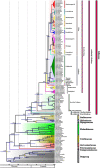Phylogeny, Age, and Evolution of Tribe Lilieae (Liliaceae) Based on Whole Plastid Genomes
- PMID: 35178055
- PMCID: PMC8845482
- DOI: 10.3389/fpls.2021.699226
Phylogeny, Age, and Evolution of Tribe Lilieae (Liliaceae) Based on Whole Plastid Genomes
Abstract
Tribe Lilieae, encompassing Lilium, Notholirion, Cardiocrinum, and Fritillaria, includes economically important crops with a horticultural and medicinal value. It is considered to be a core lineage of Liliaceae, but phylogenetic relationships within it, and the timing of the origin of individual clades, remain incompletely resolved. To address these issues, we reconstructed the evolutionary history of the tribe. We sequenced 45 Liliaceae plastomes and combined them with publicly available data (for a total of 139 plastomes) to explore the systematics, origin, divergence, and evolution of Lilieae. Our taxon sampling covers all ten sections of Lilium, all Cardiocrinum species, three Notholirion species, and major phylogenetic clades of Fritillaria. Our phylogenetic analysis confirms the monophyly of major sections/subgenera of Lilium and Fritillaria with strong support. We dated the origin of Lilieae to the Eocene, with genera and species radiations inferred to have occurred in the Miocene. The reconstruction of the ancestral area implies that Lilieae may have originated from the Qinghai-Tibet Plateau (QTP): the Himalayas and Hengduan Mountains and uplifting of the QTP likely promoted divergence within the tribe. Ancestral-state reconstructions of the bulb component number (including bulblets and scales) show a strong correlation with the genus-level phylogenetic diversity in Lilieae. They also predict that the most recent common ancestor of Lilieae had bulbs with numerous bulblets. Based on these observations, we predicted that climatic oscillations associated with the QTP uplift played an important role in the evolution of the Lilieae bulb. Our findings provide a well-supported picture of evolutionary relationships and a useful framework for understanding the pathway of bulb evolution within Lilieae, contributing to a better understanding of the evolutionary history of lilies.
Keywords: Fritillaria; Liliales; Lilium; QTP; divergence time estimate; trait evolution.
Copyright © 2022 Li, Cai, Qin, Price, Zhang, Yu, Xie, He, Zhou and Gao.
Conflict of interest statement
The authors declare that the research was conducted in the absence of any commercial or financial relationships that could be construed as a potential conflict of interest.
Figures




References
-
- Altınordu F., Peruzzi L., Yu Y., He X. J. (2016). A tool for the analysis of chromosomes: karyotype. Taxon 65 586–592. 10.12705/653.9 - DOI
-
- APG (1998). An ordinal classification for the families of flowering plants. Ann. Mo. Bot. Gard. 85 531–553.
-
- APG (2003). An update of the Angiosperm Phylogeny Group classification for the orders and families of flowering plants: APG II. Bot. J. Linn. Soc. 141 399–436. 10.1046/j.1095-8339.2003.t01-1-00158.x - DOI
-
- APG (2009). An update of the Angiosperm Phylogeny Group classification for the orders and families of flowering plants: APG III. Bot. J. Linn. Soc. 161 105–121. 10.1111/j.1095-8339.2009.00996.x - DOI
-
- APG (2016). An update of the Angiosperm Phylogeny Group classification for the orders and families of flowering plants: APG IV. Bot. J. Linn. Soc. 181 1–20. 10.1111/boj.12385 - DOI
LinkOut - more resources
Full Text Sources

